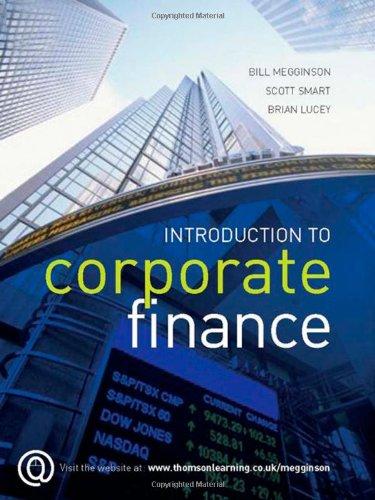Question
Eulis Co. has identified an investment project with the following cash flows. Year Cash Flow 1 $ 1,010 2 820 3 1,450 4 1,810 If
Eulis Co. has identified an investment project with the following cash flows.
| Year | Cash Flow | |||
| 1 |
| $ | 1,010 |
|
| 2 |
|
| 820 |
|
| 3 |
|
| 1,450 |
|
| 4 |
|
| 1,810 |
|
If the discount rate is 12 percent, what is the present value of these cash flows? (Do not round intermediate calculations and round your answer to 2 decimal places, e.g., 32.16.) Present value $ What is the present value at 15 percent? (Do not round intermediate calculations and round your answer to 2 decimal places, e.g., 32.16.) Present value $ What is the present value at 21 percent? (Do not round intermediate calculations and round your answer to 2 decimal places, e.g., 32.16.) Present value $
2. First National Bank charges 12 percent compounded monthly on its business loans. First United Bank charges 12.2 percent compounded semiannually. Calculate the EAR for each bank. (Do not round intermediate calculations and enter your answers as a percent rounded to 2 decimal places, e.g., 32.16.)
|
| EAR |
| First National Bank | % |
| First United Bank | % |
As a potential borrower, which bank would you go to for a new loan?
3. You are to make monthly deposits of $750 into a retirement account that pays an APR of 10 percent compounded monthly. If your first deposit will be made one month from now, how large will your retirement account be in 34 years? (Do not round intermediate calculations and round your answer to 2 decimal places, e.g., 32.16.) Retirement account value in 34 years $
4. Youve just joined the investment banking firm of Dewey, Cheatum, and Howe. Theyve offered you two different salary arrangements. You can have $8,600 per month for the next two years, or you can have $7,300 per month for the next two years, along with a $39,000 signing bonus today. Assume the interest rate is 6 percent compounded monthly. If you take the first option, $8,600 per month for two years, what is the present value? (Do not round intermediate calculations and round your answer to 2 decimal places, e.g., 32.16.) Present value $ What is the present value of the second option? (Do not round intermediate calculations and round your answer to 2 decimal places, e.g., 32.16.) Present value $
5. Youre prepared to make monthly payments of $240, beginning at the end of this month, into an account that pays 9 percent interest compounded monthly. How many payments will you have made when your account balance reaches $63,000? (Do not round intermediate calculations and round your answer to 2 decimal places, e.g., 32.16.) Number of payments
6. Suppose you are going to receive $14,500 per year for five years. The appropriate interest rate is 8 percent. a. What is the present value of the payments if they are in the form of an ordinary annuity? (Do not round intermediate calculations and round your answer to 2 decimal places, e.g., 32.16.) Present value $ What is the present value of the payments if the payments are an annuity due? (Do not round intermediate calculations and round your answer to 2 decimal places, e.g., 32.16.) Present value $ b. Suppose you plan to invest the payments for five years. What is the future value if the payments are an ordinary annuity? (Do not round intermediate calculations and round your answer to 2 decimal places, e.g., 32.16.) Future value $ What is the future value if the payments are an annuity due? (Do not round intermediate calculations and round your answer to 2 decimal places, e.g., 32.16.) Future value $ c. Which has the higher present value, the ordinary annuity or annuity due? (Click to select)Annuity dueOrdinary annuity Which has the higher future value?
7. Prepare an amortization schedule for a three-year loan of $72,000. The interest rate is 9 percent per year, and the loan agreement calls for a principal reduction of $24,000 every year. How much total interest is paid over the life of the loan? (Leave no cells blank. Enter '0' where necessary. Do not round intermediate calculations and round your answers to 2 decimal places, e.g., 32.16.)
| Year | Beginning Balance | Total Payment | Interest Payment | Principal Payment | Ending Balance |
| 1 | $ | $ | $ | $ | $ |
| 2 |
|
|
|
|
|
| 3 |
|
|
|
|
|
|
|
| Total interest | $ |
|
8. This question illustrates what is known as discount interest. Imagine you are discussing a loan with a somewhat unscrupulous lender. You want to borrow $20,000 for one year. The interest rate is 17.25 percent. You and the lender agree that the interest on the loan will be .1725 $20,000 = $3,450. So, the lender deducts this interest amount from the loan up front and gives you $16,550. In this case, we say that the discount is $3,450. What is the interest rate on this loan? (Do not round intermediate calculations and round your answer to 2 decimal places, e.g., 32.16.) Interest rate %
Step by Step Solution
There are 3 Steps involved in it
Step: 1

Get Instant Access to Expert-Tailored Solutions
See step-by-step solutions with expert insights and AI powered tools for academic success
Step: 2

Step: 3

Ace Your Homework with AI
Get the answers you need in no time with our AI-driven, step-by-step assistance
Get Started


